Liège-Bastogne-Liège was first run in 1892, Paris-Roubaix in 1896, the Tour of Flanders in 1913. These races have become legendary thanks to their rich history. The Strade Bianche race can trace its history back to 2007, a time when Jay-Z and Rihanna topped the charts. This weekend marks the tenth edition of the race. It has become an instant classic.
With new races springing up and 21 new applicants for the World Tour calendar what can the instant success of this race tell us?
What’s made this race a roaring success? It’s the same question as what makes the race a must watch this weekend: a quality field lines up in San Gimignano, a UNESCO heritage site, races over selective, dramatic roads before a majestic finish in Siena, another UNESCO heritage site. It’s a race many want to watch and most of the peloton wants to ride.
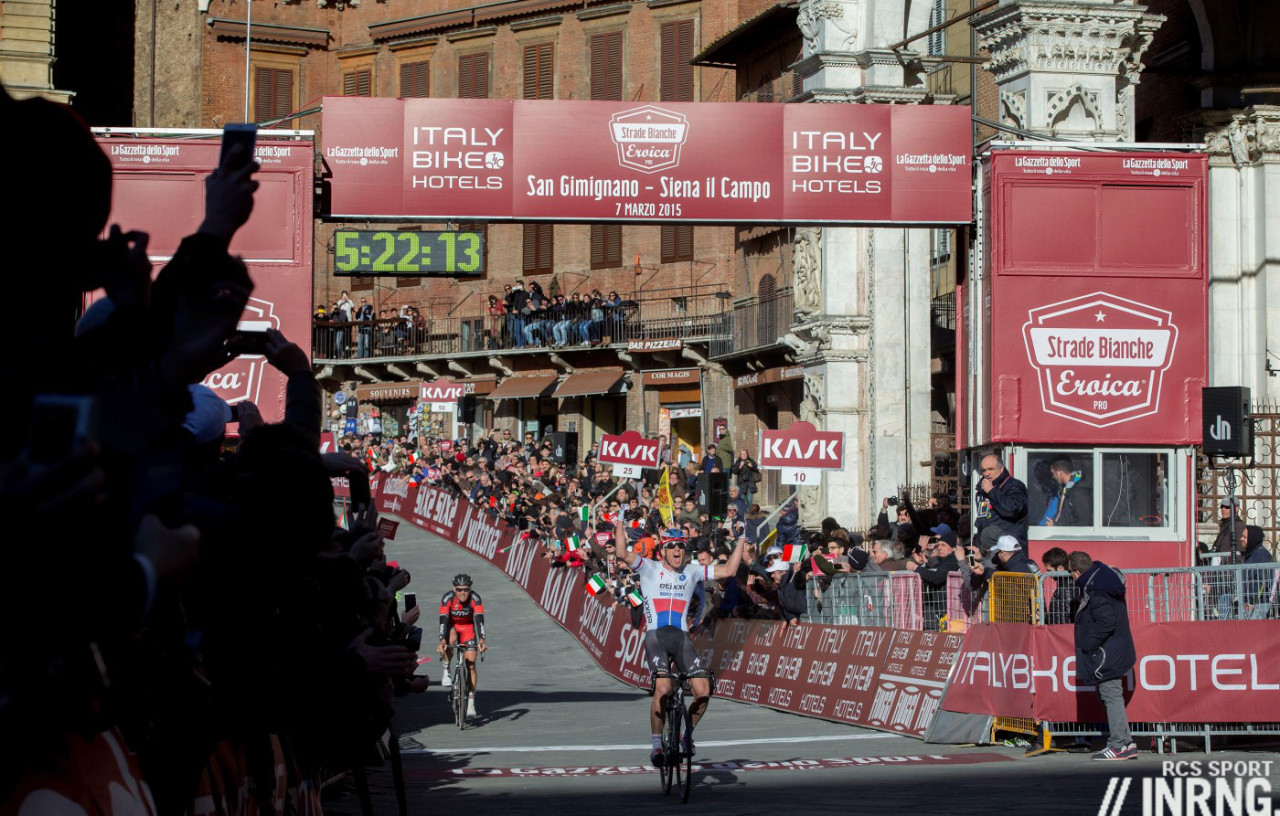
The hilly route is selective and allows classics contenders to compete alongside a few hardy stage race specialists. It works well on TV and arguably better in the photos afterwards.
The Strade Bianche exploits Italy’s rural connection. The hilltop towns, the cypress trees and other cues come straight from the tourist brochures and make this a region to ride whether in a race, a training camp or a touring holiday. Interestingly the charm of the race comes from the region as a whole, the sum total of 50km of gravel roads rather than the celebration of a particular “wall” or an infernal gravel sector in the way we respect the Kapelmuur or the Arenberg Forest.

The Strade Bianche name is itself part of the branding. Literally the “White Roads” it gives a poetic touch to roads referred to by locals as, well, “roads”: these gravel tracks are a totally normal part of the local transport network and called roads or sometimes sterrato. On a normal day people commute to work, kids are ferried to school and farmers access their fields on these tertiary roads.
From the Col de Finestre to the heel of Italy’s boot much of the country has sterrato gravel road but the Eroica is run in Tuscany, a hotbed of Italian cycling which produces a disproportionate share of the country’s professionals, from Gino Bartali to Mario Cipollini and Vincenzo Nibali made his way to this region to turn pro. This provides the cultural root onto which a pro race can be grafted, something that can’t be done in many other countries. This base explains origins of the race, it grew out of the Eroica vintage gran fondo where people ride retro bikes and road side feedzones offer salami and red wine rather than gels. Visit the region and all year round there are brown road signs that signal the route of L’Eroica. This isn’t a race that pops up overnight with neon plastic signs ziptied around the course, it’s quietly part of the landscape.

Some outside factors help too. Central Italy typically offers mild weather in March and the offroad sections mean skills practice for the classics. It’s also held before Tirreno-Adriatico race so teams need only need fly in earlier and the early slot on the calendar means we follow it as part of the classics build up. It’s run by RCS which helps with notoriety and promotion, they can reach parts of the media at home and abroad that a local organising committee cannot all while getting the race on TV. Interestingly RCS has been said to pay riders to start its events but the Strade Bianche is a race where many riders want to be, you know they show up to pin on a number rather than bank some cash. Finally sponsors like it too, US cycling has undergone a gravel cycling boom and manufacturers are keen to supply bikes to this burgeoning market and need shop windows in the pro circuit for this. Paris-Roubaix has been the traditional trade exhibition but another helps too and teams will back a race like this.
So far so good
All these reasons explain the success but they’re a problem for the rest of the sport. Want a new race? Good luck if you can’t get the right spot on the calendar, it’s not in a traditional hotbed of cycling surrounded by UNESCO sites with geography to exploit in between. Do all races have to hark back to the past and ride through rural landscapes? Is it impossible to bring the race to the people use cityscapes?
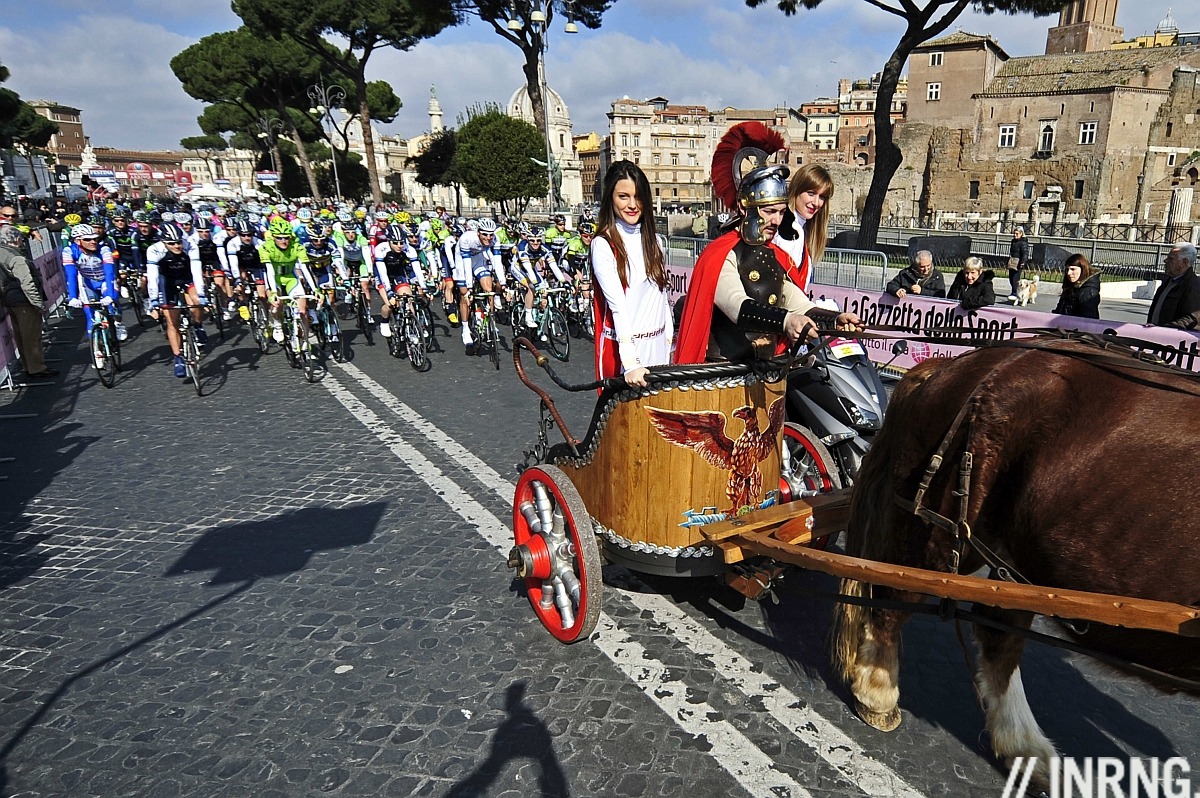
Roma Maxima derelictus
The Strade Bianche is thriving but Roma Maxima has stopped. It shared so much with the Strade Bianche: RCS’s backing, fine landscapes, history via the Giro del Lazio, tough roads and a stunning finish outside Rome’s Colosseum, scenery to rival the Tour de France’s Champs Elysées. But it’s gone, the race was dropped in 2015 with talk of a return but it’s not back now. Perhaps we had less time to grow attached to this race but its demise is something to lament as it was the only race on the calendar that actually visited the Italian capital. Even the Giro d’Italia rarely visits.

Copycats?
There are more and more gravel roads in races, at least compared to a decade ago. The upcoming Paris-Nice is going to feature some off road sectors, ideal because if you watched last year the wind never got up to split the field and the sprint finishes were inevitable. But if it’s new in Paris-Nice it’s not new to the peloton, the same sectors have been used in the Tour du Loir et Cher already and there’s even an U23 stage race in the Alps that uses gravel roads. Plus there’s the Tro Bro Leon, the best race many have not heard of. It began as an amateur race in the 1980s and exploits the ribins or ribinous in local dialect, these are gravel roads and farm tracks and takes place in a hotbed region for cycling. It all sounds familiar but remains inferior to the Strade Bianche. Part of this is down to money but for me it comes after the cobbled classics so the anticipation is reduced. It’s only live on local TV and its location in Brittany means a long journey for some even if this is another hotbed of cycling. Plus there’s no historic finish, Lannilis cannot offer the theatre of Siena.
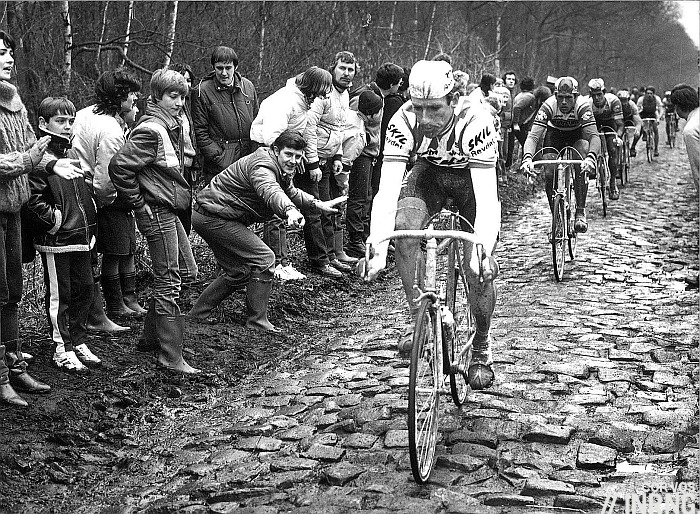
Change
The sport doesn’t have to choose between a sepia past and a digital future. The Greeks told the tale Theseus’s ship, where over the years he replaced the deck timbers and new oars were bought. In time the whole boat had changed but it was still Theseus’s ship. The same goes for today’s races, Milan-Sanremo has seen numerous course changes; Paris-Roubaix only became a cobbled demolition derby in the late 1960s. Today the route of the Tour de France is increasingly designed for television audiences; next week’s Paris-Nice uses gravel roads and so on . These races retain their name but quietly change their offering.
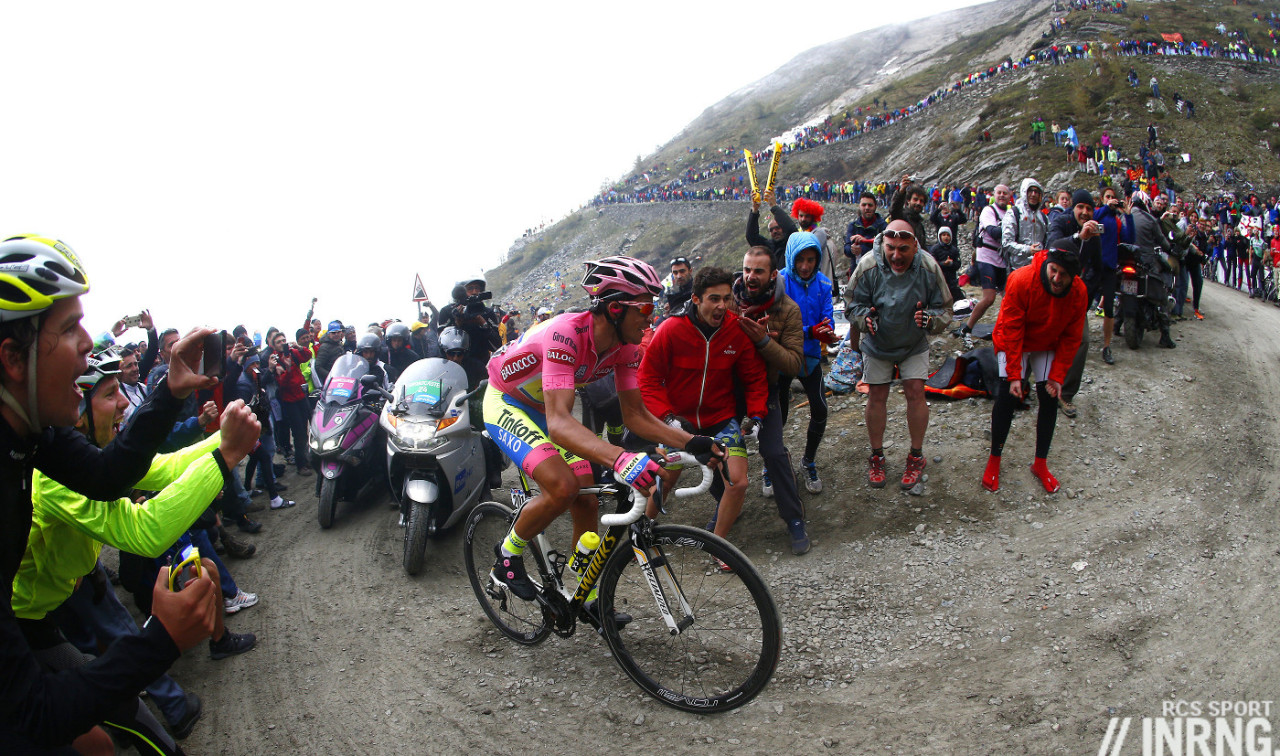
Race inflation
Does this mean a great race has to get dirty and dangerous just to compete or stay relevant? If dirt roads become the norm then we’d take them for granted. There’s a risk of inflation here where competing races start to outbid each other for infernal roads and the sport becomes a circus. But the sport is concious of this, see how ASO and RCS use the pavé and strade bianche sparingly in their grand tours.
Copy and paste
What can a new race take from the success of the Strade Bianche?
- exploit the local geography and use local features. A race on ordinary roads means an ordinary race
- borrow from the local history. The finish in the hilltop town Siena can be mimicked by arrivals next to local landmarks
- organic growth that builds on existing events helps and patience is required to make it work, a three year plan is not long enough
- why not start with a popular mass participation event? If the course is challenging and people travel to take part then the chances are it builds the foundation for a durable pro race
- Add a women‘s race. The Strade Bianche is for men and women and perhaps the UCI should be admitting new events to the World Tour after asking what they’re doing for women’s cycling?

Conclusion
The Strade Bianche is an instant success, a must-watch with almost as much prestige as some races that began in the nineteenth century. Let’s not exaggerate, nobody dreams of this ahead of the Ronde or Roubaix but it has taken a romantic hold on the sport and given it’s a physical test that cannot be fluked, winning here surely means as much as, say, the GP E3 or Paris-Tours. But without disappearing down the rabbit hole of trying to establish a hierarchy of races the point is that it’s impressive for a race in its tenth edition.
Its success is a case study in taking a new race and turning it into a hit. But replicating it elsewhere is hard, problematic even. Select geography, scenic roads and a rich history of cycling gives this race more than a head start over other new races, it provides the foundation on which to add a pro race.
- Note: loyal readers might recognise this piece. It is a rework of an older post but updated and rewritten in parts

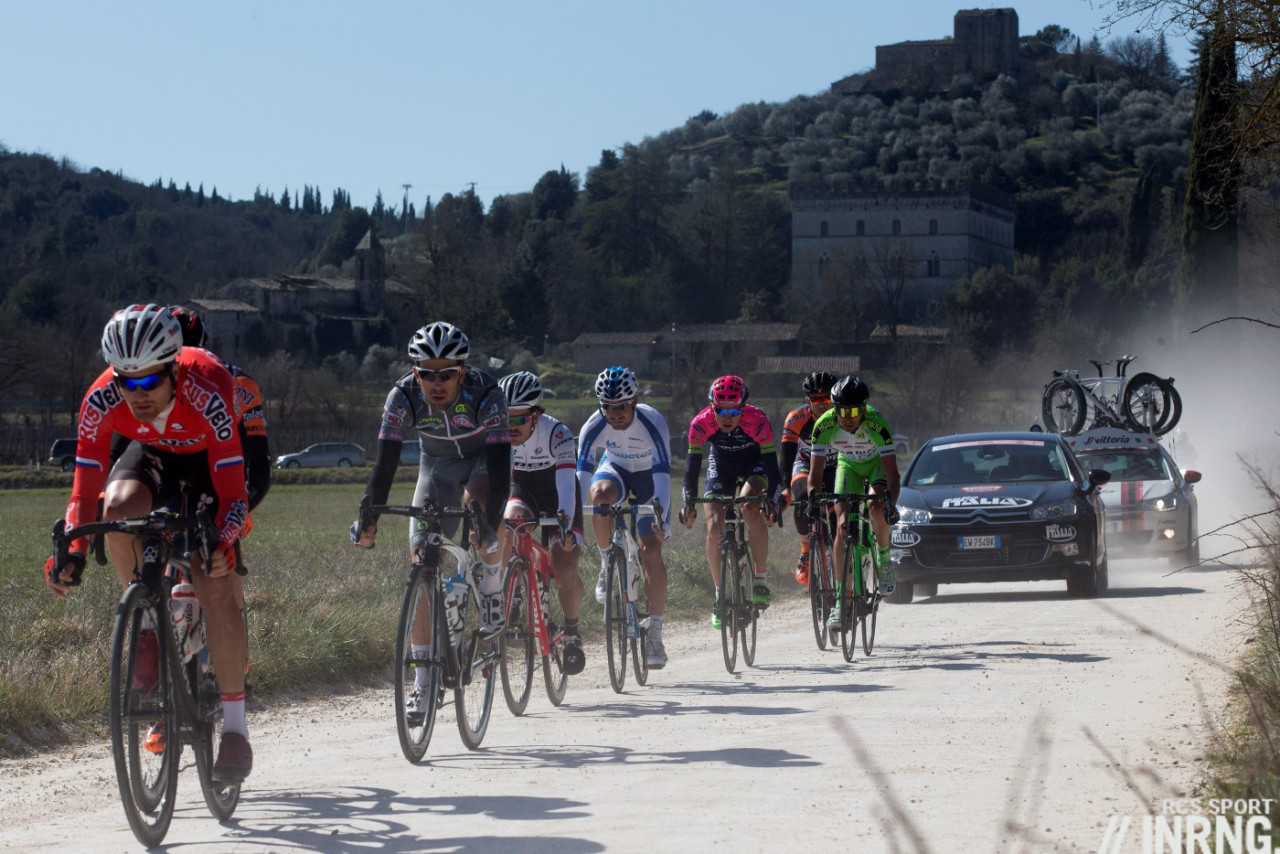
Totally agreed with this being a instant classic; just a shame no-one told British Eurosport who are only showing a delayed 45 min. Looks I’ll be browsing the pirate feeds later…
Alastair,
If you have access to Eurosport Player you’ll get 2 hours of live coverage via the extra channels. Not ideal for most I know but Britain are playing Davis Cup this weekend.
A HUGE thanks to you Mike for pointing that out to me.
AND the video feed is commentator-free. You can hear the sounds of people cheering, of bicycles being ridden. Bliss.
was just thinking that I actually prefer silence to Carlton Kirkby!
Lovely
The late David Duffield is STILL a better commentator than Carlton Kirby…
Did I miss a salute to the unique DD, IR?
Theseus’s Ship reminds me of my grandmother who once told me she’d had the same kitchen broom for 30 years and only had to replace the pole and handle 5 times and the broom head just the 8 times.
Great idea about a women’s race being required for WT status but coverage should be part of that as again no live viddy of the ladies….
Also known as Trigger’s broom.
My now 92 year old gran and Trigger have a lot in common…
…and I’m sure she loves you, too…
The Irish equivalent is Paddy’s axe, it’s been his constant companion and never let him down in all those years and has only had 5 new handles and three new heads.
My grandfather got it from him, but I own Paddy’s axe now. I just spent three hours splitting wood with it this morning. We’re way beyond 5 and 3.
Love the photos’s of the Strada with the beautiful Spring weather they seem to enjoy, as I sit here in freezing grey Blighty. I hope in the future it becomes a true feature of the Calendar and as much a monument as PR. How long that will take I don’t know but i am liking the gravel element to such races and after all were all being told we need a gravel grinder to add to the collection.
I think parcours is the main thing – that’s what makes the desert races so dull. Scenery helps, but it’s the road that matters.
Tro Bro Leon shows that timing also makes a big difference – it clashes with the Amstel, whereas Strade Bianche has little in the way of competition, plus we’re all hungry for racing.
There is something romantic about the white dust clouds as well.
I think these races are great. One of the best GT stages of recent times was stage 7 of the 2010 Giro when they went over the white roads in horrible weather. It was an epic day on what was an epic Giro. It’s good that these kind of days don’t suffer from over-familiarity though, otherwise it becomes a bit like Alps d’Huez.
The 2010 Giro stage had an element that the current pro race doesn’t have – the long backroad climb to Montalchino, it even finnished on that very difficult long climb – Eroica Gialo features this climb. I guess its just too hard for the pros with +500m of elevation, +15km, 20% sections on gravel/mud a pave section and a final 2km sprint on 10% paved surface.
If you think about the days of the year where the sport gets its biggest audiences and where the one day races tend to be, I’d start one in the high mountains of Europe: Pyrenees, Alps, Dolomites. but outside the traditional GT calendar slots. So far Lombardia is the closest to that. That would be an interesting spectacle.
Weather will play a part though, as the mountains are closed for much of the year, and when they’re not, there are stages races on them. It would probably have to be in a less traveled spot such as Columbia, and you have commercial issues then.
I’ve come to love this race.
Being presently based in eastern England, we often get the same weather as Belgium / Northern France and it can be fun to stare at the sky or feel an icy blast of a north easterly that would whip a discarded gel wrapper across to Ghent in short time.
Last Wednesday’s Le Samyn was raced on a bitter, wet, windy day which forced you to wrap up double warm venturing out, but you could still empathise with the riders battling the conditions, numbed fingers and toes. And at the end of the race, you’s think “**** me, those guys are something else”.
But this race is over my horizon, in the land of dreams, away from the industrial grime.
I want to go but, if I can’t, reading articles like this and within Inner Ring’s archives, take you there.
And, finally (ha), the quality of the racing matches the product.
Should be a cracker later.
Well I hope you take the opportunity to watch live your local gravel roads on the Melton-Rutland Ciclassic.
That is a great shout. There’s an in-depth interveiw with the race’s founder here: http://www.alwaysriding.co.uk/features/past-present-future-colin-clews/
Highlights how hard it is to not just start a race but to keep it going. It very much chimes with Inrng’s considered piece.
First edition with radios of this fan-favourite race. The influence of radios is being tested.
That’s why it’s a firm favourite already – fantastic race.
Wish I’d awakened a little earlier, but the last 20km were brilliant enough…’classic’, one might say…
Not gonna say a thing about tactics, or expectations; just enjoy the image of Fabian, bike hoisted high…
Gutted for Brambilla – brilliant ride and just seconds away – but fantastic to see Cancellara so strong.
EQS won’t be too impressed with Stybar – albeit he was up against a flying Fabian – three riders in the top ten, though, so the team is so strong.
The amount of time Puccio spent off the bike, I think he won that race by about 6 minutes.
The one thing I am most hopeful for this Spring is one final epic chapter of the Spartacus-Tommeke saga. I take today’s race as a good sign that Fabian is on top form. Loved seeing how visibly excited he was after crossing the line. This makes me look forward to Roubaix all the more.
And – also gutted for Brambilla. He really laid it all on the line.
Fully agree with you both, although Stybar was just beaten by the better man on the day.
From last weekend’s Omloop and K-B-K, midweek’s Le Samyn, and then today, what great racing.
We’re seeing aggressive and proactive moves.
Chapeau to all the riders and teams, really top notch.
Three riders in the top five and two on the podium. Not too shabby.
I think the Cadel Evans Great Ocean Road Race is trying to follow this formula. Obviously you can’t talk about much more than 150 years of history in that part of the world (although Cadel’s personal history and popularity helps), but in other instances they’re following the formula. 1. Take advantage of a free spot on the calendar (right after the Tour Down Under and right before the Herald Sun Tour). 2. Have a mass participation event and a women’s race over the weekend. 3. The money shots scenery wise are the peloton rolling along next to the famous Bell’s Beach, and while suburban Geelong is somewhat lacking in loveliness you have the tough 2010 World’s circuit to contend with.
Or Ride London Classic for that matter. Wondering if that race could benefit from not actually having to sprint it out on the mall/strand and have some late bumps throw in. Richmond park has some ups and downs and could host a finish, conversely, maybe add on a detour to Hampstead Hill before going down for the finish. There are some short but very brutal gradients there.
That said, nothing wrong with a sprinters’ one day race.
Plenty of locations in the UK that can provide a far better parcours than London and its environs (too flat) – I suspect Ride London Classic will only ever be that in name. It’s the usual London bias to hold the race there: it’s nowhere near the best place.
The routes that London proposed for the 2017 TdF grand depart looked more interesting, but they’re trying to link this one to the Olympics to help build interest in the mass participation event. I suspect that might be a bigger deal than the pro race.
They just need to run it on the actual Ocean Road, not a 5km strip after bells beach and upto Forrest rd. they could really showcase the area by going down to Lorne and up and over to Dean’s Marsh… Just a bit logistically difficult with narrow forested hilly roads and just that little bit further from the infrastructure of Geelong…
It would make for a more scenic route I agree, but I guess the focus is the start and finish in Geelong and the time of year limits the distance. They could cut out the Barwon Heads section and head south to Torquay I suppose.
I do indeed recognise this piece from time gone by, but a pleasure to read again.
You’ve mentioned Tro Bro Leon a few times and I really must try to catch it.
A couple of comments have compared other races: Le Samyn this week was epic. A wet windy Wednesday in Belgium with some pre-race articles about the new cobbles: an excellent effort from the organisers.
Cadel race: yes that ticks a lot of INRNGs points for a race to make it.
London Surrey “classic”: as INRNG said the other day- they’re adding the word ‘classic’ to give it status. But it’s dull. They’re banking on Box Hill and Buck House to wow the audience but it’s pedestrian. Far more interested in 3 hard days in Yorkshire.
Thanks!
RCS added a women’s race to Strade Bianchi only last year, a good number of years after it had already become an “instant sucess”. So, why that should be a lesson to be learned for other races is a bit of a mystery.
Because it’s a good way to add more interest and get an even wider audience, it can help a new race get more attention.
Agreed, plus adding a women’s race greatly helps to make a successful application with the UCI. Love them or not, but the UCI is very dedicated to promoting equality in the sport amongst men/women.
Now the major question is: How does adding a women’s race affect the cost/benefit analysis of holding the race. There are significant expenses to running two races in a day, and what extra TV or ad revenue does the organiser get for running a female race? I have no idea of the specifics, is anyone here more informed on this topic? I’d be very interested in hearing.
1) It looks beautiful on television.
2) It’s different.
3) Almost no chance of a large group coming to the finish together. The race is too hard for that.
4) The winner will be one of the real hard men. No question.
Great piece, great race!! And yes, I’m well aware the real racing season doesn’t start until MSR but as a pre-season event it has it all over the sandbox “vacations.” I saw it yesterday live for the 4th time
http://cycleitalia.blogspot.it/2016/03/strade-bianche-eroica-pro-2016.html but I do have to ask whether the sport truly needs a lot of new events UNLESS they offer something special and unique as this one does? Isn’t the calendar already rather crowded?
The Classics are going to be special this year I feel. Everybody is firing on all cylinders or at least getting towards that peak. Bar any crashes between here and the main events I think we will witness an outstanding year.
“why not start with a popular mass participation event? If the course is challenging and people travel to take part then the chances are it builds the foundation for a durable pro race”
That is the recipe followed by Roland Hofer and his crew for the Velothon-concept that is spreading through Europe; http://www.velothon-majors.com/en/
They also try to have it start and end in a major well-known town teaming up with the town’s branding strategy etc.
It appears to work quite well and could be just a matter of time before television arrives too.
I presidented the Velothon Wales last year and it was q pleasant surprise. On the day of the race, prior to the Pro-start, the happy amateurs – albeit better equipped than most pros 😉 – took off. The day before a local race was arranged for Junior ages and lower. Despite rain and wind, the ambience was excellent and the arrangement very well executed.
Many of the Spring classics have sportifs very near the race date already. It’s definitely a revenue opportunity. ASO actually owns a number of sportif-type events where participation is in the thousands.
If I’m not mistaken, both Tro Bro Leon and the Strade Bianchi use sportif revenue as the “seed capital” to put on the pro races.
I believe the Strade Bianche GF has been going only since 2015 so the idea that it pays for the pro race is tough to believe. I wouldn’t be surprised if RCS pays a license fee to the Eroica folks to use the name, though of course the roads are public for anyone to enjoy and the original EROICA route is signposted for this purpose. We’ll be out there for Eroica Primavera again this year. The bici d’epoca thing is way different than your typical GF, much more the atmosphere that got me into cycling in the first place when compared to these modern events, which are full of punters who “could have won the Giro if they’d only had the time”. Somehow they believe cycling’s not about talent, just a hard work ethic.
I just clicked on that link. I guess the UCI is tired of other collecting all the sportif revenue!
Yeah, I don’t know about the economics behind it but Mr. Hofer is generally well-connected and, I believe, pretty well respected as well. The societée behind the Velothons enters some form of contract with local event-makers and they presumably split the money somewhere. And the UCI endorsment as well as the organising of a pro-event (not WT, though) does cost some fees.
UH was me, I missed the J
Hey…I follow and read about cycling specifically so I don’t have to hear about crappy pop musicians. I’m calling party foul. And, I blame Shawn Carter for the awful spoken-word BS that passes for rap these days. It’s awful. Please bring back the Public Enemy, Tribe Called Quest, and De La Soul of my youth!